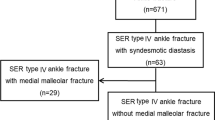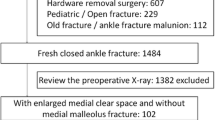Abstract
Purpose
In the athletic population, the prevalence of isolated syndesmotic lesions is high. To detect potential instability of the ankle is crucial to define those lesions in need of surgical management.
The aim was to define how the extent of tibio-fibular syndesmotic ligament injury influences the overall stability of the ankle joint in a cadaver model.
Methods
Twenty fresh-frozen through knee cadaveric leg specimens were subjected to different simulated syndesmotic ligament lesions. In Group 1 (n = 10), the order of ligament sectioning was: anterior tibio-fibular ligament (ATFL), superficial deltoid ligament (SDL), deep deltoid ligament (DDL), posterior tibio-fibular ligament (PTFL), and progressive sectioning at 10, 50 and 100 mm of the distal interosseous membrane (IOM). In Group 2 (n = 10), the sequence was: ATFL, PITFL, 10 and then 50 mm of the distal IOM, SDL, DDL, and 100 mm of the distal IOM. Diastasis of 4 mm in the coronal or sagittal plane and external rotation of the ankle greater than 20° were considered indicative of instability.
Results
Both coronal and sagittal diastasis exceeded 4 mm with injury patterns characterized by IOM lesions extending beyond 5 cm. External rotation of the ankle exceeded 20° with injury patterns characterized by a DDL lesion.
Conclusion
Coronal and sagittal plane diastases of the tibio-fibular syndesmosis are particularly affected by sequential lesions involving the IOM, whereas increased external rotation of the ankle most depends on DDL. The identification of the specific syndesmotic and deltoid ligament injuries is crucial to understanding which lesions need operative management. The knowledge of which pattern of tibio-fibular syndesmotic ligament injury influences the ankle joint stability is crucial in defining which lesions need for surgical management.
Similar content being viewed by others
Code availability
Not applicable.
Availability of data and material
All the data are reported in manuscript and tables.
References
Bartonicek J (2003) Anatomy of the tibiofibular syndesmosis and its clinical relevance. Surg Radiol Anat 25:379–386
Beumer A (2007) Chronic instability of the anterior syndesmosis of the ankle. Acta Orthop Suppl 78:4–36
Beumer A, Valstar ER, Garling EH, Niesing R, Ginai AZ, Ranstam J et al (2006) Effects of ligament sectioning on the kinematics of the distal tibiofibular syndesmosis: a radiostereometric study of 10 cadaveric specimens based on presumed trauma mechanisms with suggestions for treatment. Acta Orthop 77:531–540
Brown KW, Morrison WB, Schweitzer ME, Parellada JA, Nothnagel H (2004) MRI findings associated with distal tibiofibular syndesmosis injury. AJR Am J Roentgenol 182:131–136
Bulucu C, Thomas KA, Halvorson TL, Cook SD (1991) Biomechanical evaluation of the anterior drawer test: the contribution of the lateral ankle ligaments. Foot Ankle 11:389–393
Candal-Couto JJ, Burrow D, Bromage S, Briggs PJ (2004) Instability of the tibio-fibular syndesmosis: have we been pulling in the wrong direction? Injury 35:814–818
Cedell CA (1975) Ankle lesions. Acta Orthop Scand 46:425–445
Close JR (1956) Some applications of the functional anatomy of the ankle joint. J Bone Joint Surg Am. 38A:761–781
Ebraheim NA, Taser F, Shafiq Q, Yeasting RA (2006) Anatomical evaluation and clinical importance of the tibiofibular syndesmosis ligaments. Surg Radiol Anat 28:142–149
Edwards GS Jr, DeLee JC (1984) Ankle diastasis without fracture. Foot Ankle 4:305–312
Gerber JP, Williams GN, Scoville CR, Arciero RA, Taylor DC (1998) Persistent disability associated with ankle sprains: a prospective examination of an athletic population. Foot & ankle international. Am Orthop Foot Ankle Soc Swiss Foot Ankle Soc 19:653–660
Hollis JM, Blasier RD, Flahiff CM (1995) Simulated lateral ankle ligamentous injury. Change in ankle stability. Am J Sports Med 23:672–677
Hunt KJ, Goeb Y, Behn AW, Criswell B, Chou L (2015) Ankle Joint Contact Loads and Displacement With Progressive Syndesmotic Injury. Foot Ankle Int 36:1095–1103
Johnson EE, Markolf KL (1983) The contribution of the anterior talofibular ligament to ankle laxity. J Bone Joint Surg Am 65:81–88
Leeds HC, Ehrlich MG (1984) Instability of the distal tibiofibular syndesmosis after bimalleolar and trimalleolar ankle fractures. J Bone Joint Surg Am 66:490–503
Lin CF, Gross ML, Weinhold P (2006) Ankle syndesmosis injuries: anatomy, biomechanics, mechanism of injury, and clinical guidelines for diagnosis and intervention. J Orthop Sports Phys Ther 36:372–384
McCollum GA, van den Bekerom MP, Kerkhoffs GM, Calder JD, van Dijk CN (2013) Syndesmosis and deltoid ligament injuries in the athlete. Knee Surg Sports Traumatol Arthrosc 21:1328–1337
Ogilvie-Harris DJ, Reed SC, Hedman TP (1994) Disruption of the ankle syndesmosis: biomechanical study of the ligamentous restraints. Arthroscopy 10:558–560
Porter DA, May BD, Berney T (2008) Functional outcome after operative treatment for ankle fractures in young athletes: a retrospective case series. Foot Ankle Int 29:887–894
Stormont DM, Morrey BF, An KN, Cass JR (1985) Stability of the loaded ankle. Relation between articular restraint and primary and secondary static restraints. Am J Sports Med 13:295–300
Tochigi Y, Rudert MJ, Saltzman CL, Amendola A, Brown TD (2006) Contribution of articular surface geometry to ankle stabilization. J Bone Joint Surg Am 88:2704–2713
van den Bekerom MP, Hogervorst M, Bolhuis HW, van Dijk CN (2008) Operative aspects of the syndesmotic screw: review of current concepts. Injury 39:491–498
van Dijk CN, Longo UG, Loppini M, Florio P, Maltese L, Ciuffreda M et al (2016) Classification and diagnosis of acute isolated syndesmotic injuries: ESSKA-AFAS consensus and guidelines. Knee Surg Sports Traumatol Arthrosc 24:1200–1216
van Dijk CN, Longo UG, Loppini M, Florio P, Maltese L, Ciuffreda M et al (2016) Conservative and surgical management of acute isolated syndesmotic injuries: ESSKA-AFAS consensus and guidelines. Knee Surg Sports Traumatol Arthrosc 24:1217–1227
Watanabe K, Kitaoka HB, Berglund LJ, Zhao KD, Kaufman KR, An KN (2012) The role of ankle ligaments and articular geometry in stabilizing the ankle. Clin Biomech 27:189–195
Williams BT, Ahrberg AB, Goldsmith MT, Campbell KJ, Shirley L, Wijdicks CA et al (2015) Ankle syndesmosis: a qualitative and quantitative anatomic analysis. Am J Sports Med 43:88–97
Xenos JS, Hopkinson WJ, Mulligan ME, Olson EJ, Popovic NA (1995) The tibiofibular syndesmosis. Evaluation of the ligamentous structures, methods of fixation, and radiographic assessment. J Bone Joint Surg Am 77:847–856
Acknowledgments
Not applicable
Funding
No external source of funding was used.
Author information
Authors and Affiliations
Contributions
Conceptualization, U.G.L.; investigation, L.R.A.; methodology, V.D.; resources, V.C.; visualization, A.L.; data curation, C.F.; supervision, C.W.D.; writing-original draft preparation, F.F.; writing-review and editing, M.L.; project administration, U.T..
Corresponding author
Ethics declarations
Conflict of interest
The authors declare that they have no conflict of interest.
Ethics approval
Not needed.
Consent to participate
Not needed.
Consent for publication
The authors allow publication of this manuscript.
Additional information
Publisher's Note
Springer Nature remains neutral with regard to jurisdictional claims in published maps and institutional affiliations.
Rights and permissions
About this article
Cite this article
Longo, U.G., Loppini, M., Fumo, C. et al. Deep deltoid ligament injury is related to rotational instability of the ankle joint: a biomechanical study. Knee Surg Sports Traumatol Arthrosc 29, 1577–1583 (2021). https://doi.org/10.1007/s00167-020-06308-7
Received:
Accepted:
Published:
Issue Date:
DOI: https://doi.org/10.1007/s00167-020-06308-7




